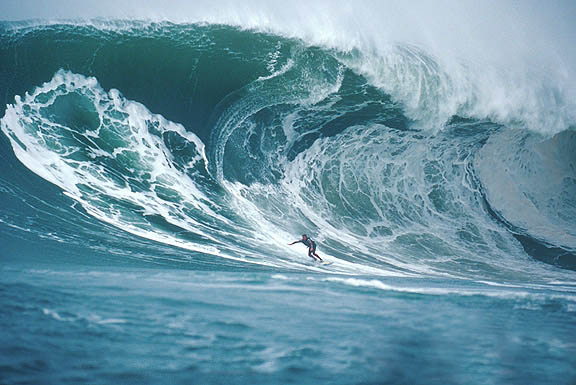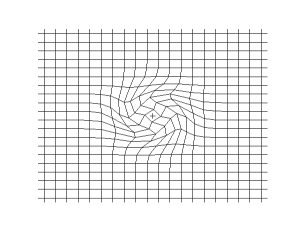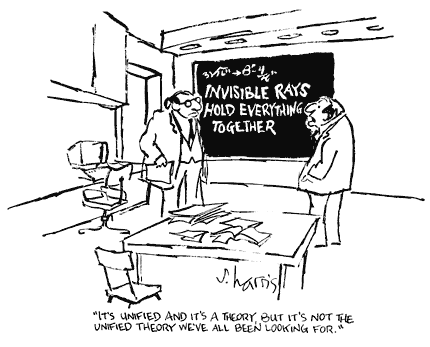This article is about waves in the scientific sense. For other uses of wave or waves, see Wave (disambiguation).
One type of wave is a mechanical wave, which propagates through a medium in which the substance of this medium is deformed. The deformation reverses itself owing to restoring forces resulting from its deformation. For example, sound waves propagate via air molecules bumping into their neighbors. This transfers some energy to these neighbors, which will cause a cascade of collisions between neighbouring molecules. When air molecules collide with their neighbors, they also bounce away from them (restoring force). This keeps the molecules from continuing to travel in the direction of the wave.
Another type of wave can travel through a vacuum, e.g. electromagnetic radiation (including visible light, ultraviolet radiation, infrared radiation, gamma rays, X-rays, and radio waves). This type of wave consists of periodic oscillations in electrical and magnetic fields.
 A main distinction is between transverse waves, in which the disturbance occurs in a direction perpendicular (at right angles) to the motion of the wave, and longitudinal waves, in which the disturbance is in the same direction as the wave.
A main distinction is between transverse waves, in which the disturbance occurs in a direction perpendicular (at right angles) to the motion of the wave, and longitudinal waves, in which the disturbance is in the same direction as the wave.Waves are described by a wave equation which sets out how the disturbance proceeds over time. The mathematical form of this equation varies depending on the type of wave.
The two types of waves :
Longitudinal wave =D
Plane pressure pulse wave and Representation of the propagation of an omnidirectional pulse wave on a 2d grid (empirical shape)
Longitudinal waves are waves that have the same direction of vibration as their direction of travel, which means that the movement of the medium is in the same direction as or the opposite direction to the motion of the wave. Mechanical longitudinal waves have been also referred to as compressional waves or compression waves.
Transverse wave =D
Transverse plane wave and Propagation of a transverse spherical wave in a 2d grid (empirical model)
A transverse wave is a moving wave that consists of oscillations occurring perpendicular (or right angled) to the direction of energy transfer. If a transverse wave is moving in the positive x-direction, its oscillations are in up and down directions that lie in the y–z plane.
If you anchor one end of a ribbon or string and hold the other end in your hand, you can create transverse waves by moving your hand up-and-down. Notice though, that you can also launch waves by moving your hand side-to-side. This is an important point. There are two independent directions in which wave motion can occur. In this case, these are the y and zdirections mentioned above. Further, if you carefully move your hand in a clockwise circle, you will launch waves that describe a left-handed helix as they propagate away. Similarly, if you move your hand in a counter-clockwise circle, a right-handed helix will form. These phenomena of simultaneous motion in two directions go beyond the kinds of waves you can create on the surface of water; in general a wave on a string can be two-dimensional. Two-dimensional transverse waves exhibit a phenomenon called polarization. A wave produced by moving your hand in a line, up and down for instance, is a linearly polarized wave, a special case. A wave produced by moving your hand in a circle is a circularly polarized wave, another special case. If your motion is not strictly in a line or a circle your hand will describe an ellipse and the wave will be elliptically polarized.
Electromagnetic waves behave in this same way, although it is harder to see. Electromagnetic waves are also two-dimensional transverse waves.
Ray theory does not describe phenomena such as interference and diffraction, which require wave theory (involving the phase of the wave). You can think of a ray of light, in optics,as an idealized narrow beam of electromagnetic radiation. Rays are used to model the propagation of light through an optical system, by dividing the real light field up into discrete rays that can be computationally propagated through the system by the techniques of ray tracing. [1] A light ray is a line or curve that is perpendicular to the light's wavefronts (and is therefore collinear with the wave vector). Light rays bend at the interface between two dissimilar media and may be curved in a medium in which the refractive index changes. Geometric optics describes how rays propagate through an optical system.[1]
This two-dimensional nature should not be confused with the two components of an electromagnetic wave, the electric and magnetic field components, which are shown in the electromagnetic wave diagram here. The light wave diagram shows linear polarization. Each of these fields, the electric and the magnetic, exhibits two-dimensional transverse wave behavior, just like the waves on a string.
The transverse plane wave animation shown is also an example of linear polarization. The wave shown could occur on a water surface.
Transverse waves are waves that are moving perpendicular to the direction of propagation.
Damping Oscillation =D
 Oscillation is the repetitive variation, typically in time, of some measure about a central value (often a point of equilibrium) or between two or more different states. Familiar examples include a swinging pendulum andAC power. The term vibration is sometimes used more narrowly to mean a mechanical oscillation but sometimes is used to be synonymous with "oscillation". Oscillations occur not only in physical systems but also in biological systems and in human society.
Oscillation is the repetitive variation, typically in time, of some measure about a central value (often a point of equilibrium) or between two or more different states. Familiar examples include a swinging pendulum andAC power. The term vibration is sometimes used more narrowly to mean a mechanical oscillation but sometimes is used to be synonymous with "oscillation". Oscillations occur not only in physical systems but also in biological systems and in human society. 








